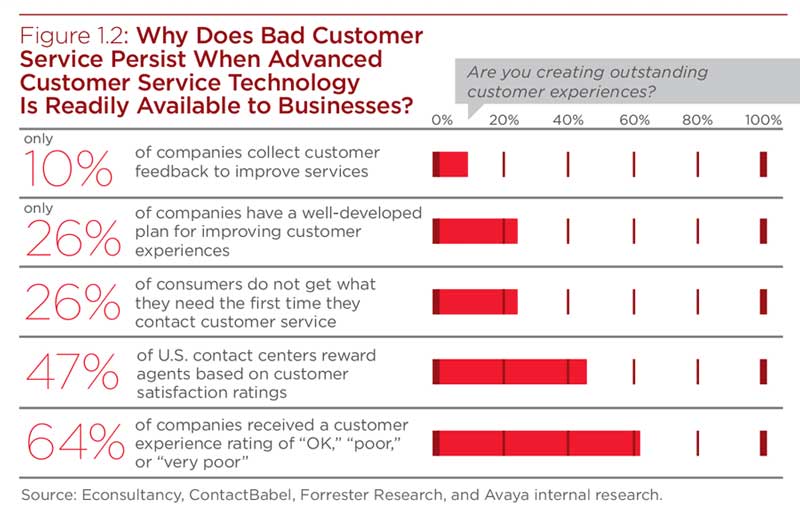The Demographic Shift Is Changing Customer Expectations
Consumer behaviors and expectations for service have changed dramatically in recent years, impacting how customer service must be delivered. As the post–World War II baby boomer generation moves into retirement, its demographic followers—often referred to in the media as Generations X and Y—are becoming major forces in the economy.
This generational shift is apparent in the consumerization of IT, where devices like smartphones and tablets have rapidly become devices for the masses. Members of Generation Y were the early adopters, but these devices are now widely embraced by all demographics and age groups, who use them for work, research, school, and entertainment. Seamless communication via voice, video, and chat—along with widespread Internet connectivity—drives behaviors such as impromptu social media posts, “anytime, anywhere” email access, and instantaneous text messaging.
Consider how social media is changing the face of customer service. Though perceived by some as a relatively small channel for customer service today, social media is rapidly growing in relevance. For example:
—CustomerServiceScoreboard.com
Ninety percent of consumers will share their experiences across their social networks, and they expect organizations to have some presence in the social world (callcentres.net, 2011).
Thirty-four percent of consumers want to receive a response within 15 minutes through social media sites like Facebook and Twitter (Avaya and BT research, 2013).
Sixty percent of companies don’t respond to customers via social media, even when asked a direct question (Capgemini, 2011).
Customers interacting with organizations through social media will spend more money with the organization (Echo Research, 2012).
All these trends are shaping new expectations in customer experience.
Changing Expectations and Perceptions of Service
For example, customers accustomed to instantaneous response via social media may become frustrated when their requests are not handled within minutes. Organizations that understand today’s customer service and sales reality and how it impacts the customer experience have an opportunity to foster loyalty and drive the longer-term value of the customer.
Despite the near-universal acknowledgment of the importance of customer service, the gap between customers’ expectations and the ability of companies to fulfill them keeps widening.
Only 26 percent of consumers agreed that they received excellent service (callcentres.net, 2011).
At the same time, as many as 49 percent of consumers disagreed at some level with the notion that customer support centers provide excellent service, while another 26 percent were neutral.
CustomerServiceScoreboard.com states the matter bluntly:
“Most people believe they receive inadequate customer service from most companies today.”
With customer behaviors and business environments changing faster than ever, defining a strategy built around a holistic customer experience has its challenges. These changes impact every business and influence not only what constitutes a good customer experience—but also the requirements for delivering it.
Increasing Economic and Competitive Pressures
Organizations are challenged to spend less and generate more. In the midst of a struggling economy, tremendous pressure to maintain top-line revenue and margins remains. Revenue opportunities come and go at a rapid pace, adding additional economic pressures. These pressures compel organizations to focus on growth and revenue without adding costs to their operations.
Delivering an exceptional customer experience is often associated with the interactions between customers and company representatives; however, since labor is generally the largest organizational expense, companies increasingly focus on how to deliver the ideal customer experience through less labor-intensive means such as integrated voice response systems and self-service Web portals.
Globalization and e-commerce have prompted organizations to find innovative ways to differentiate themselves in a competitive environment. While improving customer service is one area of differentiation, the challenge involves doing so in a way that drives revenue and growth without adding costs. For example, online retailers such as Amazon.com use automated email systems that alert customers when a product has shipped and make product recommendations based on past purchases.
The Impact of Marketplace Changes on the Customer Experience
These communication behaviors and service expectations have an impact. For example:
High expectations. Generations X and Y grew up surrounded by media-oriented technology while enjoying rapid improvements in computing functionality and performance. Given this experience, they expect instantaneous service and immediate access to answers and information—often at the click of a mouse. They become puzzled when service is not available anywhere, anytime, through any medium. They want personalized service with organizations knowing who they are, where they are, what they want, and how they have interacted in the past. And they want it now.
Preferred modes of interaction with the organization: none. Today’s customers are media agnostic, having grown up using the phone, email, Web chat, IM, and social media interchangeably. They are comfortable, and may even prefer, communicating online versus face to face or over the phone.
Empowerment and knowledge. The ways that consumers make buying decisions and gather information are changing, too. Reaching out to peers via social media or doing some form of self-service means that the average consumer tends to be more self-sufficient and knowledgeable on a particular subject. Recent research indicates that 58 percent of consumers believe they have received better help from other consumers than from agents, and 70 percent believe they know more about the problem than the agent does (Avaya and BT, 2013). Thus, customers may only contact an organization if they can’t find the answer elsewhere.
Going viral. Not only is their tolerance for failure limited, but today’s customers also don’t hesitate to go public with their dissatisfaction. Activities include posting messages, photos, and videos online. Many major brands have experienced this firsthand—and not always to their liking.
Multiple factors are having an impact on customer experience today: demographic changes, technology advancements, economic pressures, and more. These factors are changing what customers expect from the organizations they purchase from, how they make their purchasing decisions, and what drives their overall level of satisfaction. Organizations have to recognize and adapt to these changes if they are to succeed in today’s increasingly competitive business environment.

